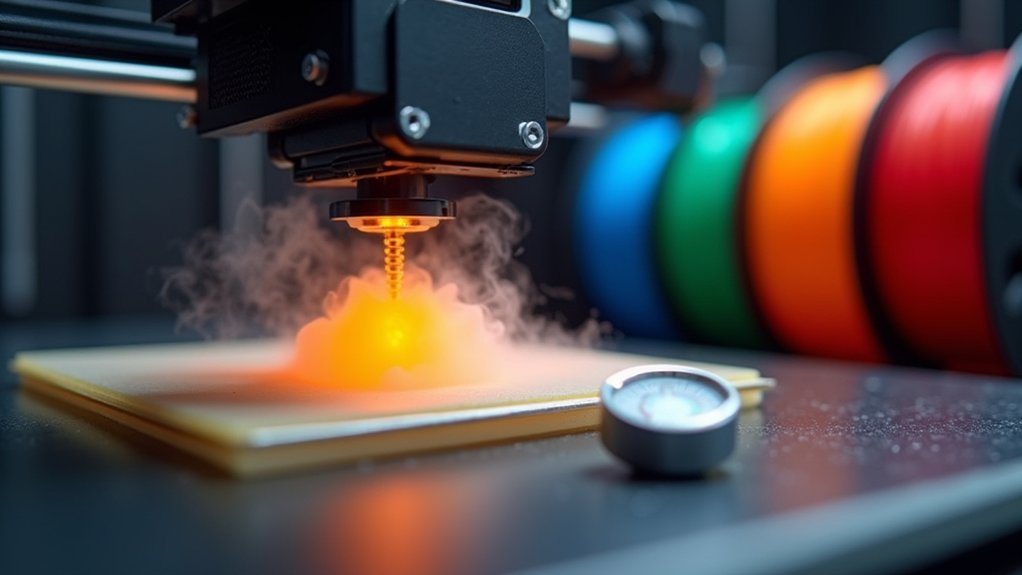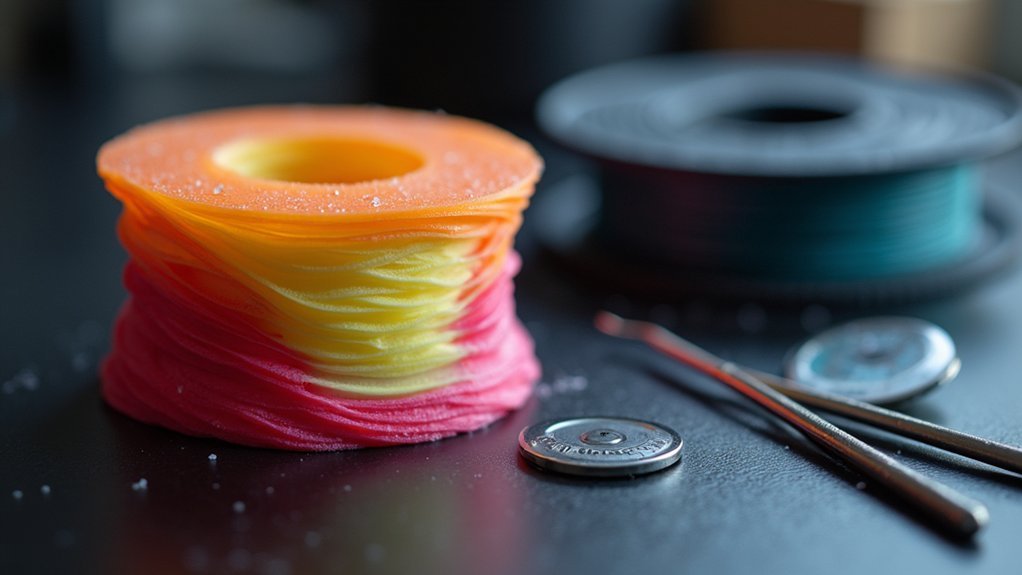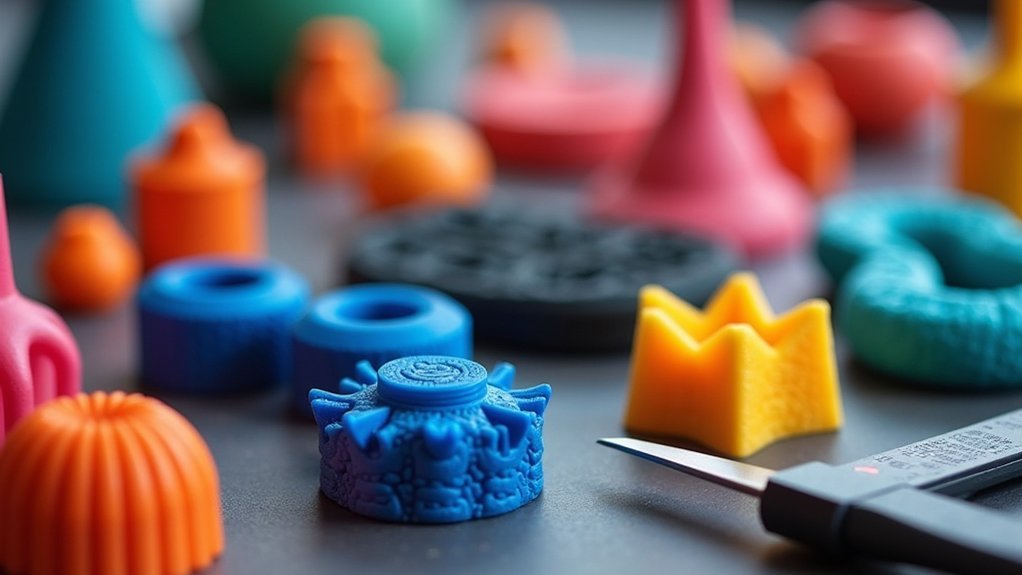You’ll achieve professional multi-material prints by maintaining precise temperatures—190-220°C for PLA and 220-260°C for ABS—while setting your heated bed to 110°C for ABS sections. Increase your purge volume from standard 250mm³ to 2500mm³ for ideal layer adhesion between materials. Use PLA as support material for ABS parts to guarantee clean removal, and apply glue sticks or textured PEI surfaces for improved bed adhesion. Master these fundamentals and you’ll discover advanced techniques that transform challenging prints into consistent successes.
Temperature Management for PLA ABS Layer Adhesion

When printing with both PLA and ABS materials, you’ll need to carefully manage extruder temperatures to achieve proper layer adhesion between these dissimilar plastics.
Maintain PLA temperatures between 190-220°C and ABS between 220-260°C for ideal melting and bonding. Set your heated bed to 110°C for ABS sections while adjusting appropriately for PLA shifts. Your print bed temperature directly impacts adhesion strength, so don’t overlook this critical factor.
Temperature precision is crucial—maintain PLA at 190-220°C, ABS at 220-260°C, and set bed temperature to 110°C for optimal adhesion.
Implement gradual temperature adjustments during material changes, as even small variations considerably affect bonding quality.
Consider enhancing retraction settings to prevent oozing during shifts. Monitor ambient temperature since it influences cooling rates and warping.
Scripts like Nikolai-rs can automate temperature management between materials. Proper temperature management guarantees reliable layer adhesion and prevents delamination in your multi-material prints.
Purge Volume Optimization Between Material Changes
Achieving ideal purge volume between PLA and ABS material changes requires substantially more plastic than you might expect.
You’ll need approximately 2500mm³ for optimal material adhesion, as typical 250mm³ volumes deliver only one-fifth of expected bonding strength. This increased purge volume maintains consistent extrusion flow and temperature stability, which directly impacts your multi-material prints’ success and bed adhesion quality.
Monitor your temperature settings throughout the purging process, since improper thermal management compromises bonding between materials.
Test different purge volumes on smaller models first to identify minimum requirements before tackling larger projects.
Consider using scripts like Nikolai-rs to better manage temperature changes during material alterations. This approach greatly improves your overall print quality and layer adhesion reliability.
Bed Adhesion Techniques for Mixed Material Success

Beyond proper purge volumes, successful mixed material printing depends heavily on optimizing your bed adhesion strategy.
You’ll need to balance temperature requirements since ABS demands a heated bed around 110°C while PLA prints best at lower temperatures. This temperature difference can create adhesion challenges when shifting between materials.
Apply a glue stick or use textured PEI surfaces to improve bed adhesion for both filaments.
Textured PEI surfaces and glue sticks provide reliable bed adhesion solutions for challenging multi-material printing applications.
Accurate bed leveling is essential—uneven surfaces cause poor first layer bonding. Test different adhesion techniques and temperature combinations to prevent warping and maintain print stability.
Configure your print settings to include a brim, especially for intricate designs with minimal print bed contact.
This enhancement greatly improves adhesion for both PLA and ABS sections of your mixed material projects.
Support Material Selection and Removal Strategies
While bed adhesion forms the foundation of successful mixed material printing, selecting the right support material becomes equally essential for complex geometries involving both PLA and ABS.
You’ll achieve ideal results by using PLA as support material for ABS parts, creating clean separation and smooth surface finishes.
For effective support strategies, consider these approaches:
- Design zero-clearance supports for easy removal without damaging your primary print.
- Enable tree supports in slicing software like PrusaSlicer for complex shapes, though watch for potential alignment shifts.
- Apply sufficient adhesive to your print bed and enable brims for better adherence during printing.
- Experiment with lightweight honeycomb configuration to balance printing stability with post-print removal ease.
Smart support material selection transforms challenging dual-material projects into manageable prints.
Troubleshooting Common PLA ABS Bonding Issues

Even with ideal support materials in place, you’ll likely encounter bonding challenges when working with PLA and ABS together.
Start with proper temperature management – set your extruder temperature to 190-220°C for PLA and 220-250°C for ABS. Configure your heated bed to 110°C for ABS sections to prevent warping.
If you’re experiencing poor layer adhesion, increase your purge volume from the standard 250mm³ to around 2500mm³. Fine-tune retraction settings and optimize cooling to minimize stringing during material shifts.
Before committing to full-scale projects, conduct test prints with scaled-down models to evaluate bonding performance between PLA and ABS.
These test prints allow you to adjust settings and identify potential layer adhesion issues early in your print process.
Frequently Asked Questions
What Are the Best Settings for ABS Print?
You’ll need 220-250°C extruder temperature and 110°C heated bed. Use PEI surface or glue stick for adhesion. Level your bed properly, disable cooling fans initially, and guarantee correct Z-offset for successful prints.
What Are the Tips for Printing ABS?
You’ll need a heated bed at 110°C, use PEI surfaces, level carefully, maintain stable ambient temperatures with enclosures, and clean your extruder regularly to prevent clogs and achieve consistent ABS prints.
Is It Better to Print ABS Fast or Slow?
You should print ABS slowly, around 30-50 mm/s for best results. Slower speeds improve layer adhesion, reduce warping, and minimize stringing. For intricate details, you’ll want even slower speeds of 20-30 mm/s.
Can You Print ABS and PLA Together?
You can print ABS and PLA together, but they’ll have poor layer adhesion. You’ll need to test bonding strength, manage different temperatures carefully, and increase purge volumes for better results.





Leave a Reply